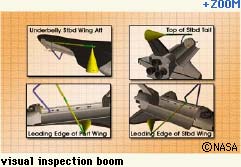 |
 |
February 1 was the first anniversary of the Space Shuttle Columbia accident, in which seven precious lives were lost. We have not overcome the profound sadness caused by the loss of its crew, our fellow astronauts, but we believe that what we can do for them is to return to flight in the safest manner as early as possible. For this, we have been united as a team and have worked hard to realize our goal of returning to flight, with this September as our target.
Last August, the Columbia Accident Investigation Board (CAIB) published a report with strict recommendations regarding not only technical issues for a safe return to flight, but also issues related to the organization and culture at NASA. All the people at NASA, including astronauts, have accepted the recommendations unreservedly. We have been doing our utmost to solve the problems, one by one, based on CAIB's recommendations.
The Return to Flight Task Force has been supervising NASA from a third-party point of view, in order to ensure that NASA takes all the appropriate measures recommended by CAIB.
 As part of the process to return to flight, people at NASA's Johnson Space Center have been working on the damage inspection system for the Shuttle's Thermal Protection System (TPS) and the techniques to repair the damage with extra-vehicular activities (EVA). As a representative of the NASA Astronaut Office, I have been involved in the development of the on-orbit TPS inspection boom. As part of the process to return to flight, people at NASA's Johnson Space Center have been working on the damage inspection system for the Shuttle's Thermal Protection System (TPS) and the techniques to repair the damage with extra-vehicular activities (EVA). As a representative of the NASA Astronaut Office, I have been involved in the development of the on-orbit TPS inspection boom.
The Columbia accident was caused by a piece of insulating foam which fell off the External Tank and struck the Shuttle's wing, creating a breach in one of the Reinforced Carbon Compound (RCC) panels. During re-entry, this breach allowed superheated air to penetrate the insulation and melt the structure of the wing, causing the Shuttle to break up. |
 |
1/4 |
 |
|
 |
 |